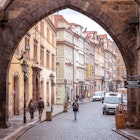
Dec 19, 2025 • 7 min read
Cuba has a range of accommodations, from simple private homestays to luxurious all-inclusive resorts. Here’s all you need to know.

Dec 19, 2025 • 7 min read
Cuba has a range of accommodations, from simple private homestays to luxurious all-inclusive resorts. Here’s all you need to know.

Dec 19, 2025 • 6 min read
Whether you call it chai, cha, chaha, choi or sah, tea is a necessity in most of India. Here's what you need to know.

Dec 19, 2025 • 14 min read
Magical doesn’t come close to describing the wonder that lit up the sky all night long on a 5-day dream trip to see the northern lights in Fairbanks, Alaska.

Dec 19, 2025 • 9 min read
Seattle can be an expensive city to visit, but we've rounded up top attractions that won't cost you a dime.

Dec 19, 2025 • 6 min read
St Lucia has a well-earned reputation as a blissfully tranquil place to visit. Make it even easier with local tips on the climate, costs and customs.

Dec 19, 2025 • 9 min read
These are the most exciting train routes for 2026.

Dec 19, 2025 • 11 min read
Where do you begin to explore the storied, sprawling city of İstanbul? Start with these 16 top experiences.

Dec 19, 2025 • 6 min read
Latin American and the Caribbean are where Carnivals truly come alive. Find the perfect celebration for you with this ultimate guide.

Dec 18, 2025 • 9 min read
Low-key Bonaire is known for its world-class diving but offers far more than underwater adventures. Here are some of the best things to do in Bonaire.

Dec 18, 2025 • 7 min read
From clifftop pools in the wilderness to luxury spa-like experiences, these are the best hot springs in Oregon.

Dec 18, 2025 • 9 min read
From cultural adventures in and around Cairo to hot-air balloon rides in Luxor, here's our guide to Egypt's very best experiences.

Dec 18, 2025 • 6 min read
Budapest’s seventh district, once home to a flourishing Jewish community which languished for decades after WWII, has emerged as one of the best bar…

Dec 18, 2025 • 7 min read
Getting around the country of Belize can be an adventure in itself. Here are our top tips for a successful journey.

Dec 18, 2025 • 4 min read
If you’re looking for the best time of year to visit Sedona, we've got the perfect seasonal guide to the weather and the best things to do.

Dec 18, 2025 • 5 min read
Take a mini beach getaway from Barcelona by heading to one (or all!) of the beaches on our list.

Dec 18, 2025 • 15 min read
A visit to Antarctica is a once in a lifetime experience. Here’s how to plan for the trip, including itineraries, insider tips and the best ships to sail on.

Dec 18, 2025 • 6 min read
The volcanic Cycladic island of Milos is much-loved for its luminous waters, secret beaches and authentic Greek charm. Here's what to do when in Milos.

Dec 18, 2025 • 4 min read
Learn about Iran's rich history and culture through these books, films and songs.

Dec 18, 2025 • 4 min read
Put these books, movies and music on your playlist before going to Portugal, plus what to pack and a local glossary.

Dec 18, 2025 • 12 min read
Here are 15 of our favorite things to do in Eastern Europe.

Dec 18, 2025 • 6 min read
Here's everything you need to know about the Caledonian Sleeper, including buying tickets and food, and enjoying the facilities.

Dec 18, 2025 • 13 min read
In Europe, the next great adventure is always just a quick ferry, train ride or flight away.